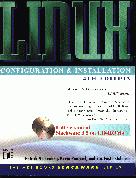

Even though this book covers installation of a Slackware Linux distribution, I do think it contains much that will benefit new users as well as advanced users installing different distributions.

Authors: Patrick Volkerding, Kevin Reichard and Eric Foster-Johnson
Publisher: IDG
E-mail: siteemail@idgbooks.com
Price: US $39.99 (softbound, with 2 CDs)
ISBN: 0-7645-7005-6
Reviewer: Bob van der Poel
It seems like only yesterday I sent off an order to Walnut Creek for the Slackware 96 CDs. When I received the four-CD set, it came with a tiny installation manual which I followed to the last detail. A few hours later, I had Linux (kernel 2.0.0) running on my PC. Since that eventful day, I have not reinstalled Linux on my main system, so I'm still running the same system. Thus, I have a bias toward Slackware, as it is what I use.
I have played with other distributions. Red Hat is no harder or easier to install, and SuSE comes with a much more novice-friendly manual. I'd recommend Slackware to those who have more than a passing knowledge of computers and operating systems.
Linux Configuration & Installation is an enhanced version of the pamphlet which is shipped with the Walnut Creek distributions—a much enhanced version. The 560-page book comes with two CD-ROMs. The first is the standard Slackware installation with the 2.0.34 kernel—not the latest and greatest, but certainly a stable version. The second CD has a number of other packages, mostly with full source. Unlike previous versions of Slackware in which you need to create boot disks, you can now boot directly off the CD for your initial installation if your BIOS supports this, and most newer ones do. The CD can also be used as a rescue disk.
Chapter 1 (a full 43 pages) covers the hardware requirements for a successful installation. I'm sure if your hardware problem isn't covered here, you'll have great difficulty finding it anywhere else. I should also point out that this version of Linux is only for an Intel PC architecture.
Chapters 2 and 3 cover the actual installation of Linux on your PC and configuring the X Window System. Again, a good amount of detail is presented. In Chapter 4, the authors detail advanced issues: recompiling a custom kernel, printers and networking.
If you are using a laptop, you'll find Chapter 5, “Portable Computing Devices”, very useful. There is not a lot of text in this chapter; essentially, it just tells you that Linux works with most laptops. The useful part is a list of over 500 models and brands of laptops known to be compatible, and problems you can expect with some combinations. Many web resources are listed for optimizing specific models.
The remainder of the book, Chapters 6 to 9, covers Internet issues, a summary of basic Linux commands and applications and basic system administration.
My only complaint is some of the detail in the first half becomes almost painful to wade through. You may find it useful in certain situations, and as such, it is a good resource. I loaned the book and CDs to a friend who isn't a computer guru, but is mildly interested in trying out Linux. He's installed Windows 95/98 dozens of times, so has some knowledge. He spent a bit of time reading the book, decided it was all too complicated, and never even bothered trying to boot from the CD. I think my friend is more typical than many readers of this magazine might care to admit. I understand other distributions are addressing the fear of installation much better than Slackware.
The second part of the book, the various overviews, are an excellent introduction for people who haven't yet earned any UNIX merit badges. It will not make a wizard out of a new user, but should start them out on the correct path. I'm sure that if my friend had simply booted the disk, followed the on-screen instructions, then used this part of the book as a reference, he would have managed the install quite successfully. Quite correctly, the authors mention they are only touching on many topics and recommend further resources.
One actual weakness I discovered in the book was the way printers are handled. Setting up Ghostscript is covered in a short section, but there isn't any advice on handling some fairly basic and, to the new user, difficult problems. I can only assume the authors had an expensive PostScript printer hooked up to their own Linux boxes and were spared learning how to write “stair-step” filters and custom printcap files. Many printer problems are easily handled with print filters, but no mention of this is made.
Even though this book covers installation of a Slackware Linux distribution, I do think it contains much that will benefit new users as well as advanced users installing different distributions. I will certainly keep it as a reference. The authors certainly know their subject, but I have to wonder if all this detail is necessary.